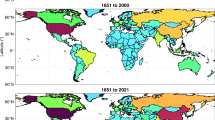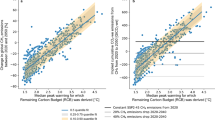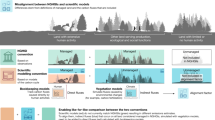Abstract
Climate change policies need to consider the contribution of each emitting region to the increase in atmospheric carbon dioxide. We calculate regional attributions of increased atmospheric CO2 using two different assumptions about land sinks. In the first approach, each absorber region is attributed ‘domestic sinks’ that occur within its boundaries. In the second, alternative approach, each emitter region is attributed ‘foreign sinks’ that it created indirectly through its contribution to increasing CO2. We unambiguously attribute the largest share of the historical increase in CO2 between pre-industrial times and the present-day period to developed countries. However, the excess CO2 in the atmosphere since pre-industrial times attributed to developing countries is greater than their share of cumulative CO2 emissions. This is because a greater fraction of their emissions occurred more recently. If emissions remain high over the coming decades, the share of excess CO2 attributable to developing countries will grow, and the sink service provided by forested regions—in particular those with tropical forest—to other regions will depend critically on future tropical land-use change.
This is a preview of subscription content, access via your institution
Access options
Subscribe to this journal
Receive 12 print issues and online access
$209.00 per year
only $17.42 per issue
Buy this article
- Purchase on Springer Link
- Instant access to full article PDF
Prices may be subject to local taxes which are calculated during checkout


Similar content being viewed by others
References
Le Quéré, C. et al. The global carbon budget 1959–2012. Earth Syst. Sci. Data Discuss. 5, 1107–1157 (2012).
Report of the Conference of the Parties on its thirteenth session, held in Bali from 3 to 15 December 2007 FCCC/CP/2007/6/Add.1 (UNFCCC, 2008); available at http://unfccc.int/resource/docs/2007/cop13/eng/06a01.pdf#page=8.
Steffen, W. et al. The terrestrial carbon cycle: Implications for the Kyoto protocol. Science 280, 1393–1394 (1998).
United Nations Framework Convention on Climate Change (United Nations, 1998); available at http://untreaty.un.org/cod/avl/ha/ccc/ccc.html.
Schulze, E-D., Valentini, R. & Sanz, M-J. The long way from Kyoto to Marrakesh: Implications of the Kyoto Protocol negotiations for global ecology. Glob. Change Biol. 8, 505–518 (2002).
Takahashi, T. et al. Climatological mean and decadal change in surface ocean p CO 2, and net sea–air CO2 flux over the global oceans. Deep-Sea Res. II 56, 554–577 (2009).
Denman, K. L. et al. in IPCC Climate Change 2007: The Physical Science Basis (eds Solomon, S. et al.) 499–587 (Cambridge Univ. Press, 2007).
Trudinger, C. & Enting, I. Comparison of formalisms for attributing responsibility for climate change: Non-linearities in the Brazilian Proposal approach. Climatic Change 68, 67–99 (2005).
Den Elzen, M. et al. Analysing countries’ contribution to climate change: Scientific and policy-related choices. Environ. Sci. Policy 8, 614–636 (2005).
Höhne, N. et al. Contributions of individual countries’ emissions to climate change and their uncertainty. Climatic Change 106, 359–391 (2011).
Gitz, V. & Ciais, P. Amplifying effects of land-use change on future atmospheric CO2 levels. Glob. Biogeochem. Cycles 17, 359–391 (2003).
Boden, T. A., Marland, G. & Andres, R. J. Global, Regional, and National Fossil-Fuel CO2 Emissions (US Department of Energy, 2010).
Norby, R. J. et al. Forest response to elevated CO2 is conserved across a broad range of productivity. Proc. Natl Acad. Sci. USA 102, 18052–18056 (2005).
Friedlingstein, P. et al. Climate-carbon cycle feedback analysis; results from the C4MIP model intercomparison. J. Clim. 19, 3337–3353 (2006).
Cox, P. M., Betts, R. A., Jones, C. D., Spall, S. A. & Totterdell, I. J. Acceleration of global warming due to carbon-cycle feedbacks in a coupled climate model. Nature 408, 184–187 (2000).
Le Quere, C. et al. Trends in the sources and sinks of carbon dioxide. Nature Geosci. 2, 831–836 (2009).
IPCC, Special Report on Emissions Scenarios (eds Nakicenovic, N. & Swart, R.) (Cambridge Univ. Press, 2000).
IMAGE team The IMAGE 2.2 Implementation of the SRES Scenarios; A Comprehensive Analysis of Emissions, Climate Change and Impacts in the 21st Century (RIVM, Bilthoven, 2001).
Joos, F. et al. An efficient and accurate representation of complex oceanic and biospheric models of anthropogenic carbon uptake. Tellus 48(B), 397–417 (1996).
Ciais, P. & Moore, B. Integrated Global Carbon Observation Theme: A Strategy to Realize a Coordinated System of Integrated Global Carbon Cycle Observations (2001).
Crisp, D. et al. The Orbiting Carbon Observatory (OCO) mission. Adv. Space Res. 34, 700–709 (2004).
Gitz, V. & Ciais, P. Future expansion of agriculture and pasture acts to amplify atmospheric CO2 levels in response to fossil-fuel and land-use change emissions. Climatic Change 67, 161–184 (2004).
Gitz, V. Usage Des Terres et Politiques Climatiques Globales PhD thesis (in French), Presses Académiques Francophones (2003).
Gitz, V., Hourcade, J. C. & Ciais, P. The timing of biological carbon sequestration and carbon abatement in the energy sector under optimal strategies against climate risks. Energy J. 27, 113–133 (2006).
Friedlingstein, P. et al. On the contribution of CO2 fertilization to the missing biospheric sink. Glob. Biogeochem. Cycles 9, 541–556 (1995).
Houghton, R. A. Revised estimates of the annual net flux of carbon to the atmosphere from changes in land use and land management 1850–2000. Tellus B 378–390 (2003).
Alcamo, J. et al. in Global Change Scenarios of the 21st Century, Results from the IMAGE 2.1 Model (eds Alcamo, J., Leemans, R. & Kreileman, E.) 97–139 (Elsevier, 1998).
Houghton, R. A. Emissions of Carbon from Land-use Change (Cambridge Univ. Press, 1997).
Acknowledgements
This paper is a contribution to the efforts of the Global Carbon Project, a joint project of the IGBP, WCRP, IHDP and Diversitas, to track and analyse the interactions among the carbon cycle, human activities and the climate system.
Author information
Authors and Affiliations
Contributions
P.C. designed the study and wrote the text. T.G. prepared the model set-up, conducted the simulations and contributed to the text. J.D.P. contributed to the model set-up and to the text, and made the key figures. K.C., M.R.R., J.G.C., A.P., P.F. and S.L.P. contributed to the interpretation of the results and to the text. V.G. developed the original OSCAR model and contributed to the text.
Corresponding author
Ethics declarations
Competing interests
The authors declare no competing financial interests.
Supplementary information
Rights and permissions
About this article
Cite this article
Ciais, P., Gasser, T., Paris, J. et al. Attributing the increase in atmospheric CO2 to emitters and absorbers. Nature Clim Change 3, 926–930 (2013). https://doi.org/10.1038/nclimate1942
Received:
Accepted:
Published:
Issue Date:
DOI: https://doi.org/10.1038/nclimate1942
This article is cited by
-
National contributions to climate change due to historical emissions of carbon dioxide, methane, and nitrous oxide since 1850
Scientific Data (2023)
-
National attribution of historical climate damages
Climatic Change (2022)
-
Climate Warming Mitigation from Nationally Determined Contributions
Advances in Atmospheric Sciences (2022)
-
Climate warming from managed grasslands cancels the cooling effect of carbon sinks in sparsely grazed and natural grasslands
Nature Communications (2021)
-
Short-lived climate forcers have long-term climate impacts via the carbon–climate feedback
Nature Climate Change (2020)



